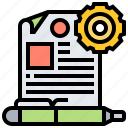Nutritional Status and Physical Activity of Elementary Students in Bandung during the Covid-19 Pandemic
Abstract
Introduction: During this Covid-19 pandemic, Exercising and doing physical activity is very necessary to keep the body in shape, but students tend to do a lot of sedentary behavior because they required to stay at home. Sedentary behavior and student health are interrelated because a dangerous sedentary lifestyle increases many diseases and deaths. This study aims to identify nutritional status and physical activity of elementary students in Bandung during the Covid-19 pandemic.
Methods: This study using corelational analytic with cross-sectional design. The data collection tools on this research using quisioner that divided into 2 parts. Subject research choosing based on inclusion criteria on this research are student that registered in dapodik data when the research was conducted, no suffer from chronic and congenital disease, and surely provide to be a respondent.
Results: The result of the variety analytics showed nutritional status of school-aged children and 84,2 % has normal body mass index and 72,6% has normal height. Based on table 3, 49 of student do sedentary activity and 46 do moderate, 43 of student do physical activity during sport session about one time, and 2 of them not doing it at all, 50 of student sitting on their spare time, 48 of student sittting on their school break, 43 of student do physical activity after school about 2-3 times, 62 student do physical activity in afternoon about 1-3 times, 39 of student do physical activity on weekends about one times, and their parent's perception about physical activity was 1-2 times do physical activity on spare time.
Conclusion: Most children have normal nutritional status, although most children behave sedentary. The results of this study are expected to be an awareness for parents and teachers to encourage children to do more physical activity because hildren who move a lot can avoid obesity and are more fit, especially during this Covid-19 pandemic..
Keywords
Full Text:
PDFReferences
Dedeh Kurniasih, H. H. (2010). Sehat & Bugar Berkat Gizi Seimbang. Jakarta: PT.Gramedia.
Fitrian Rama Aditya, M. H. (2021). Analisis Gaya Hidup Sehat Siswa Kelas XII SMAN 14 Semarang di Era Pandemi Covid-19. Journal of Physical Activity and Sports(JPAS) Volume 2, Nomor1.
Heather A, E.-M. Y. (2018). Evidence for the age-specific relationship of food insecurity and key dietary outcomes among US children and adolescents. Nutrition Research Reviews.
Kementrian Kesehatan Republik Indonesia. (2018). Hasil Utama RISKESDAS 2018. Jakarta.
Khasanah, D. (2016). Hubungan Aktivitas Fisik Dengan Status Gizi Remaja Putri di Pondok Pesantren Ta'mirul Islam Surakarta. Program Studi Ilmu Gizi, Fakultas Ilmu Kesehatan.
Leo Agung Prasetyo, F. N. (2022). Hubungan Pola Hidup Sehat dengan Status Gizi Siswa di Masa Pandemi Covid-19. Jurnal Pendidikan Olahraga dan Kesehatan Volume 10 Nomor 1 .
Listyani Hidayanti, S. Z. (2012). Prediksi Peningkatan Fungsi Motorik dan Status Gizi Anak Malnutrisi yang Anemia Setelah Suplementasi Multi-Mikronutrient. Surakarta: Jurnal Kesehatan, ISSN 1979-7621, Vol. 5, No. 1.
Maya Amaliyah, R. D. (2021). Pola Konsumsi Makan Remaja Di Masa Pandemi Covid-19. Jurnal Tata Boga.
Nicholas Kuzik, ,. B. (2022). School-related sedentary behaviours and indicators of health and well-being among children and youth: a systematic review. International Journal of Behavioral Nutrition and Physical Activity.
Taras, H. (2005). Physical Activity and Student Performance at School. Journal of School Health Vol. 75 No.6.
UNS/SCN . (2005). Crisis Situations Report n° 6 Summary. United Nations System Standing Committee on Nutrition. Geneva.
World Health Organization. (2022). Physical inactivity a leading cause of disease and disability, warns WHO. Genewa, Swiss: Department News.
DOI: https://doi.org/10.17509/jafn.v3i1.50665
Refbacks
- There are currently no refbacks.
Copyright (c) 2022 Journal of Applied Food and Nutrition

This work is licensed under a Creative Commons Attribution-NonCommercial-ShareAlike 4.0 International License.




